3/1/2025
Winter Trade Show Highlights
Chris Beytes & Jennifer Zurko
A mash-up of products from MANTS
It’s been a number of years since I’ve been at the Mid-Atlantic Nursery Trade Show (MANTS), but the general mood I remember is the same: always upbeat, probably because it’s the first trade show after the holidays. But this year there was also a note of relief in the air—relief that 2024 is over.
Quite a few green businesses didn’t have as successful a spring as they would have liked, especially in the Northeast part of the country, so turning the page to a new year was very much welcomed. Bad weather before and after may have kept some people at home, but they still had over 10,000 attendees brave the cold and snow, which shows just how eager people were to be out and about networking and seeing new products.
A couple of highlights from a couple of days of aisle-walking:
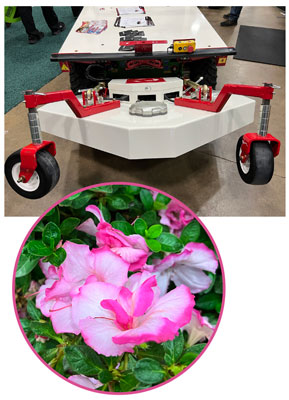 A mowing Burro
A mowing BurroIf you watched my coverage of the N.G. Heimos Poinsettia Open House, you would have seen the Burro Grande following me around the greenhouse. The first time we saw it was last year at Cultivate and since then Ryan Clifford, Senior VP of Revenue at Burro, said they’ve been busy producing their autonomous rack and equipment movers for multiple operations around the country. But they’ve also been looking at more ways to make the Burro Grande even more useful to help growers save on labor.
At MANTS, they introduced one of those ways—the Cortador (which means “cutter” in Spanish), a mower that can be attached to the Burro Grande. A lot of greenhouses have grass, weeds and brush around the property that needs to be cut on a regular basis and now you can use the Burro Grande instead of asking one of your employees to do it. Similar to its tasks in the greenhouse, you can program the Burro Grande and Cortador to mow specific areas guided by GPS, including in between rows at a nursery or in mum fields. It’ll also let you know if it’s run into an obstacle.
You don’t have to attach and detach the Cortador every time, either—you can just lift it up when you don’t need it.
An Encore kiss
Normally, we see the folks at Plant Development Services, Inc. at their stop at the California Spring Trials, so I’ll save most of their new stuff for that. But one I did want to talk about here is one of their newest introductions in their popular line of Encore Azaleas, Autumn Kiss.
Similar to other dwarf types, Autumn Kiss is compact, growing 3.5 ft. x 3.5 ft., with medium green foliage and you get unique bicolor blooms from spring to fall in Zone 6a. Autumn Kiss makes 35 total in the Encore collection and Buddy Lee said he’s still actively breeding for more. You can buy liners of Autumn Kiss now for the 2026 season.
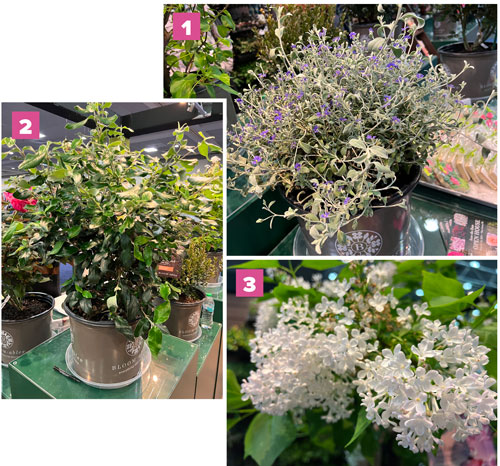 Star has lots to celebrate
Star has lots to celebrateAt the Star Roses and Plants booth, one of the main highlights was the beginning of a year-long celebration for the 25th anniversary of Knock Out Roses. There aren’t any new introductions in Knock Out for 2026, but there will be plenty to focus on, with a National Knock Out Day the Friday before Mother’s Day (this year it’s on May 9) and special 25th anniversary POP. A big marketing campaign for consumers and retailers is in the works, too.
1. Star was also showcasing some of their new woodies. A native to Australia, Dampiera Purple Oz is a very drought-tolerant shrub that’s ideal for the Southwest. Purple flowers appear on silver foliage from June to October and you can treat is as an annual, using it as a filler in combo containers. Zone 8.
2. Vibernum Snowy River produces a heavy flush of white flowers in the spring over glossy, green leaves, with red berries appearing in the fall, so it’s got multi-season interest. It’s a bit smaller than other vibernums—no more than 4.5 ft.—so it makes for a great foundation plant. And it’s free branching without the need for a lot of pruning. Zone 5.
3. The New Age series of lilacs has a new one called Pink Flush because the flowers open pink and then mature to white. And it’s super early, too—finishes in one year compared to others on the market that usually finish in three. Besides being resistant to powdery mildew, it doesn’t need as many chill hours to flower—it’ll even flower in Louisiana, they say. And as with many lilacs, the fragrance is heavenly. Zone 5.
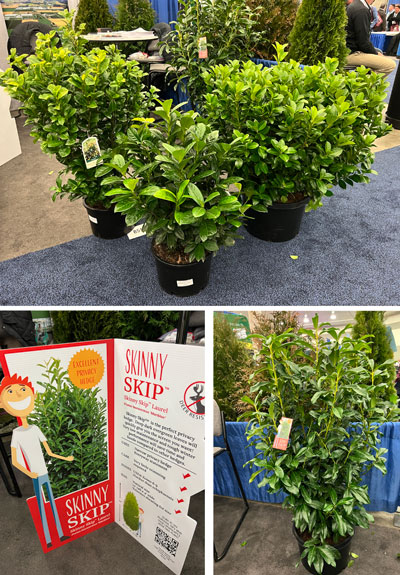 Tall, skinny and everything in between
Tall, skinny and everything in betweenWoodburn Nursery started producing floral azaleas at their farm in Oregon in the late 1960s and is now the largest “pot-in-pot” nursery in the country at 200 total acres (meaning they grow in containers placed in the ground instead of directly in the soil). At MANTS this year, they were showcasing three new laurels that they’re putting into a new collection of hardy varieties that can be planted in Zone 5a.
Volcano grows upright and straight to 60-in. tall. Shiny, dark green foliage stays evergreen all year round with new shoots emerging in a bronze red color (hence the name). Greenfinity is compact and busy, growing 60-in. tall with a more lime green foliage color. Green Goblet is the shortest of the three at 48-in. high, so it would make an ideal border or accent shrub. All are resistant to shot hole disease (which is caused by a fungus that laurels get) and don’t really flower, so they spend all of their energy on producing more green shoots.
Woodburn was showing one other standalone laurel that I liked because of the name and branding behind it. Skinny Skip is a narrow-type laurel that’s best used as a privacy hedge or against a side of a house. It stays skinny naturally, growing to 12-ft. tall. It doesn’t grow out as much, so it needs very little trimming, and it’s hardy to Zone 5a. The smiling guy on their signage seems happy with his laurel—he looks like a good Skip.
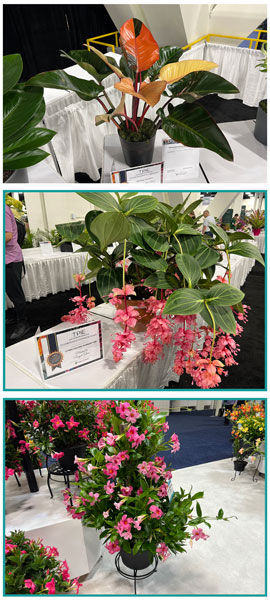 The Tropical Plant International Exhibition
The Tropical Plant International ExhibitionAs far as we know, TPIE, held the third week of January each year in Ft. Lauderdale, Florida, is the most popular tropical plant show in the world, drawing attendees from more than 40 countries who are seeking the latest in foliage and flowering tropicals, plus all the accessories that go along with selling them. (For those accessories—and a couple of neat plants—check our Ellen Wells’ coverage in Green Profit.)
Here, I’ll focus primarily on genetics … but I’m bound to include a hardgood or two I think you need to try.
Candy Stripe Brake Fern
From fern specialist Casa Flora in Texas, this is Candy Stripe, a brake* fern (Pteris aspericaulis var. tricolor) that features bright pink new growth that gradually softens to a blend of green, cream and pink. It’s good for shade gardens, terrariums or as a houseplant.
Oh, some Casa Flora news: To make more use of their tissue culture lab experience and capacity, they’re getting into native plants. Many ferns are natives, so it’s a natural extension of what they’ve been doing well for years.
* From Wikipedia: The term “brake,” used for members of this genus, is a Middle English word for “fern” from southern England. Its derivation is unclear and is generally thought to be related to “bracken.”
Philodendron Red Congo Variegated
TPIE attendees picked this one as their Favorite New Foliage Plant for its amazing green, red and gold color patterns. From Penang Nursery, who called it “rare” in their display, but who says they’ve got availability, so maybe not quite as rare anymore (although it may have sold out by the time you read this).
Uncommon Roots by Urban Jungle
The houseplant division of LiveTrends launched this line last year, but they’re worth a mention because of the unique nature of the plants and the growing techniques. Things like “ant plant” (Hydnophytum papuanum) with the cool holes in its succulent base and Alocasia macrorrhizos. Some are grown on water; others climb up poles.
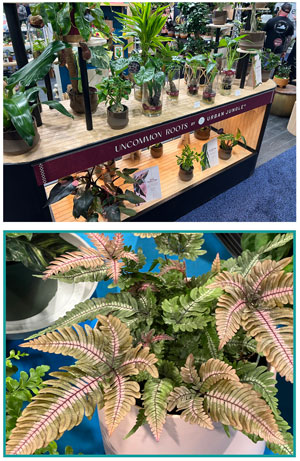 Medinilla Royal Glow
Medinilla Royal GlowThis stunner was picked by attendees as the Favorite New Flowering Plant. Royal Glow from Living Colors Nursery is a lovely selection of this tropical shrub with big pink flowers and boldly ribbed foliage. Medinilla aren’t the easiest plants to keep, so it’s not for the beginner or faint-of-heart. But what a show-stopper a big specimen would be in your garden center surrounded by smaller plants.
Sundenia Suprema Vivid Pink
Another new Sundenia Dipladenia from Suntory, Vivid Pink is in their Suprema collection, which they call “the best of both worlds:” the big, vibrant flowers of mandevilla combined with the easy growth of dipladenia. It joins Suprema Crimson. Suntory also showed a new SunParasol FiredUp Coral and an upgrade to the original SunParasol XP Pink (for better branching and more flower power).
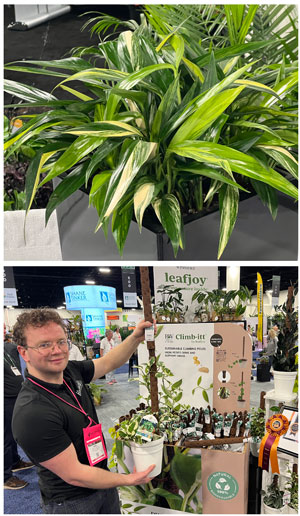 Epipremnum amplissimum Variegata
Epipremnum amplissimum VariegataCosta Farms offered a ton of new varieties—there were 10 in the Exhibitor Showcase alone. They included some very interesting monsteras and unusual scindapsus. But if we’d have to pick just one to mention, it would be Epipremnum amplissimum Variegata because it’s like no pothos we’ve ever imagined before. With its long strap leaves we’d have guessed it to be some sort of dracaena. Collectors may know about it, but it hasn’t been available in commercial quantities until now. It has the same climbing/trailing habit and easy-care attributes of a regular pothos, making it good for newbies and collectors alike.
Climb-itt
Here’s that one hardgood, and what better for plants than poles up which they can climb? The new Climb-itt products from Proven Winners’ leafjoy comes from Europe, where it’s made from a combination of potato skins and elephant grass, making it 100% natural with no plastics or chemicals. Available in various diameters, they can be stacked together to keep your plant supported as it grows. This is Mikel Olierook, developer of the base product the poles are made of.
IPM Essen
The world’s largest horticulture show, held at the end of January each year in Essen, Germany, is the place to spot the European trends and bring them here to North America. Two key products categories we look for are labor-saving technologies and environmentally friendly products—categories the Europeans are forced to excel at due to the economic and political climate they operate in. But we can’t ignore the beautiful plants on display! Here’s some of what we found:
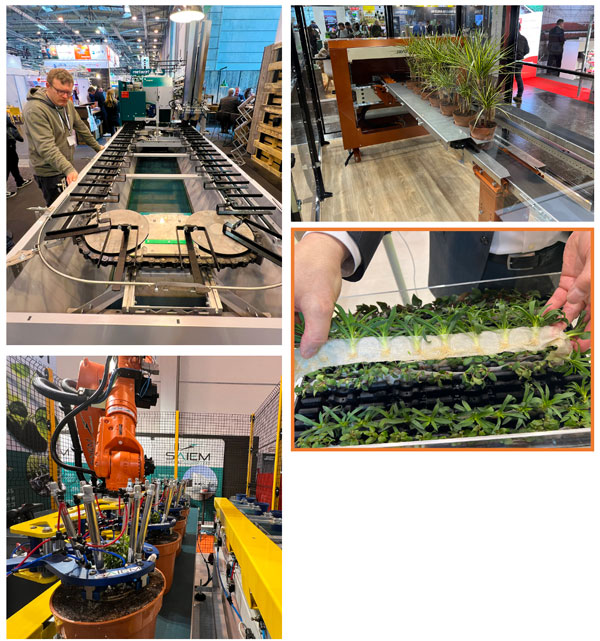 Saiem robot-mounted transplant head
Saiem robot-mounted transplant headItaly’s Saiem Nursery Automation, which has been around since 1979 designing industrial electrical systems and doing nursery automation since 2016, showed its first transplanter, designed for bumping up of small nursery pots into larger containers—like 6-in. pots into 3 gal. and the like. Rather than build an entire machine, they created a four-station head that mounts to an off-the-shelf industrial robot arm. It’s the first prototype, destined for field trials with one of their customers, so perhaps we’ll see more nursery transplanter technology from them.
Mayer 7500 pot filler
Germany’s Mayer, which makes some excellent carousel-style pot fillers, elongated the deck on its new 7500 Filler to allow it to sit next to and supply a standard bedding plant transplanter. Capacity is 12,000 pots per hour.
Javo Compact spacing robot
Javo, of the Netherlands, upgraded an old design for a pot space that has no overhead structure, making it useful for tall or top-heavy plants, whether foliage or nursery stock. Called the Compact, the spacing forks pass under the conveyor belt when returning to pick up new plants, which saves time and makes for a compact footprint. PLC controls ensure smooth operation and no vibration.
Selecta One’s RCS 2.0
German plant breeder Selecta One quietly showed what could be a major innovation in offshore rooted cuttings: something they’re calling RCS 2.0—for Rooted Cutting System. The 2.0 after the name is because it’s a culmination of all that has come before it, they say. It’s vegetative cuttings rooted in a folded paper—much like germinating seeds on a damp paper towel. Advantages are no plastic and it’s biodegradable (environmentally friendly), lightweight (lower shipping cost) and compact (ditto). Available as strips or singulated. It can be planted with a robot cutting sticker like a TTA or ISO cutting sticker or even by hand.
Right now they’re being produced in Kenya for shipping to Europe. No word on availability in the U.S.
 Asplenium antiquum Yuaspgio Gioia
Asplenium antiquum Yuaspgio GioiaWe spotted this one in the novelties competition area where it won the Foliage Indoor Pot Plants category. From Vitro Plus, this bird’s nest fern sports pointy, holly-like fronds. It’s only lacking one thing: a pronounceable cultivar name.
Cissus quadrangularis
We spotted this cool specimen during the last hour of the last day—it’s Cissus quadrangularis. A relative of good old grape ivy, this succulent is named for its unusual square stems. It was in the Bunnik Creations booth and we know they have plant friends all around the world—in fact, some Americans were in the booth drinking coffee when we snapped this photo. Perhaps they were working a deal …
Oasis Renewal floral foam
Kent, Ohio-based Smithers-Oasis debuted an innovative new flower foam called Renewal that’s completely plant-based—no petroleum products at all. However, florists can be assured it works and feels just like the Oasis foam they know and love. Its plant-based formulation has gotten a top certification by TÜV Austria and its carbon footprint is 56% smaller than regular Oasis floral foam. It’s gray-green when dry and rich black when wet, so it blends into arrangements nicely. That’s Global Sustainability Manager Kristin Bienia showing it off.
Poinsettia Fantasy Star Pink
From Selecta One, Fantasy Star Red and Orange are both available in North America. Will Fantasy Star pink come this way, too? We don’t see why not. GT